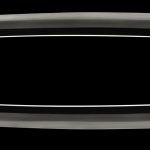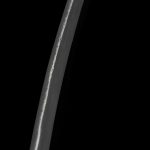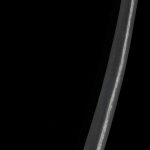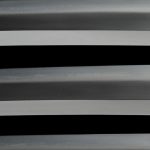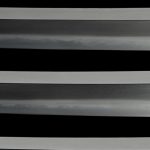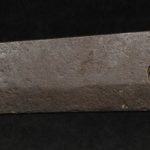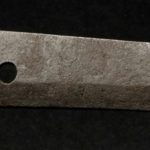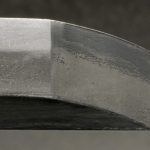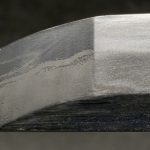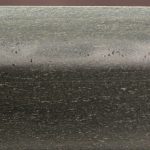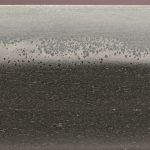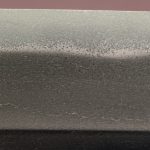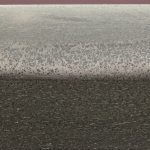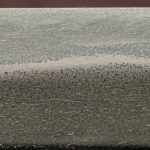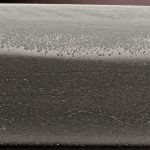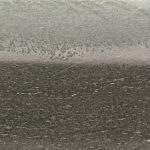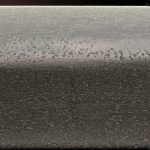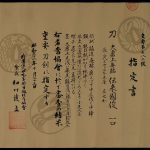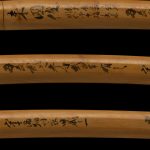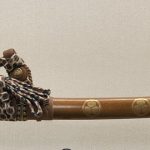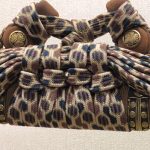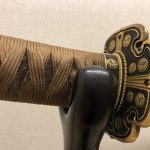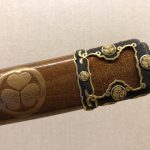RAI KUNITOSHI / NBTHK JUYO / ITOMAKI KOSHIRAE
RAI KUNITOSHI
Exquisite Kamakura Period Tachi from the famous Rai school smith Kunitoshi.
Kunitoshi was born in 1241 and was the son of Rai Kuniyuki and grandson of Rai Kuniyoshi.
This sword was a family treasure of the Hosokawa Family.
The noted sword scholar and author Kanzan Sato states in his sayagaki that this sword is one of Kunitoshi’s top ten (10) works.
From the Juyo Kanteisho:
11th “Important Sword” Appraisal Session
Tokyo
Tarōra Sadao (name of person who submitted the sword)
Sword – Greatly shortened and unsigned. “Den Rai Kunitoshi” (one item) 伝来国俊
Dimensions: Length of two shaku, three sun, two bu, five rin. (70.33cm). Curvature of 7 bu (2.12cm). Width at base of 9 bu, 2 rin (2.28cm). Width at tip of 6 bu, 4 rin (1.93cm). Length of tip is 1 sun (3.03cm). Length of tang is 5 sun, 5 bu (16.67cm). Very slight curvature in the tang.
Shape: Horizontal ridge line in-between the cutting edge and the back edge, running the length of the sword, and ending in a vertical ridge line where the tip area begins (shinogi-zukuri). The back edge of the sword is peaked (iori-mune). The sword is shortened, with slight curvature, and medium-length tip.
Forging pattern: Wood grain with some straight grain. Steel crystals appear in the blade area.
Temper pattern: Wide and straight, with slight wave pattern, interspersed with crystalline structures that extend from the edge of the temper pattern line towards the blade and away from the tip. Very fine temper line of cloudy crystalline structures with some visible grains of crystal.
Tip: Straight temper pattern in parallel with the edge, but curving backwards at the very end of the tip, with crystal in the temper pattern leading away from the edge in a “brush-stroke” pattern.
Tang: Greatly shortened with a low, rounded end. File marks that slope shallowly downward. Two peg-holes. Unsigned.
Explanation
The most reasonable theory is that Rai Kunitoshi is the grandson of Kuniyuki (国行), and the son of “Niji Kunitoshi” (二字国俊), and there is an extant work of his bearing the inscription “Shōwa 4, aged 75 years” (1315), so we can be certain of the time in which he lived. This particular sword is unsigned and greatly shortened, but the steel grain that resembles wood grain with some straight grain patterns running through it, as well as the so-called “Rai Steel” showing on both sides mixed in with the much-praised loose-steel, and also the straight temper line with fine steel crystals present with delicate lines of crystals descending from the top of the hamon, etc., all show the characteristic features of this smith’s style. Indeed, even though it has touch of tiredness, it is a sword of exceptionally well-made steel.
Kanzan Sayagaki:
來國俊 – Rai Kunitoshi
但大磨上無銘也 – Osuriage and mumei.
同作中十指之出来 – Its quality is one of the top ten of the smith’s works.
刃長貳尺参寸貳分余有之 – Blade length is a little longer than 2-shaku 3-zun 2-bu.
宇土藩細川家旧蔵之一 – One of the collection of Uto-han Hosokawa family
昭和丗七年晩秋(? unsure)日 – Showa 37th year, late autumn(?)
寒山誌 – Kanzan wrote.
If you are interested in owning this exquisite sword, contact me directly at: Yakiba.com@gmail.com
